一般现在时特殊疑问句
- 格式:ppt
- 大小:192.00 KB
- 文档页数:9

一般现在时的特殊疑问句的结构特殊疑问词。
特殊疑问句是需要用问号来标记的一种句子,它们在问句中扮演着重要的角色。
特殊疑问词通常用来引导特殊疑问句,它们能够告诉我们问句中正在寻求哪种类型的信息。
在一般现在时的特殊疑问句中,常用的特殊疑问词包括:1. What:表示“什么”,用来询问物品、事物或动作等的名称、种类以及功能。
What do you do?(你做什么工作?)。
What is your name?(你叫什么名字?)。
What do you want for lunch?(午餐你想吃什么?)。
2. Who:表示“谁”,用来询问人称或对象。
Who is your best friend?(谁是你最好的朋友?)。
Who are you talking to?(你在和谁说话?)。
(谁要来参加聚会?)。
3. Where:表示“哪里”,用来询问地方或位置。
Where is the library?(图书馆在哪里?)。
Where do you live?(你住在哪里?)。
Where did you go for your holidays?(你去哪里度假了?)。
4. When:表示“什么时候”,用来询问时间或事件发生的时间。
When do you have class?(你什么时候上课?)。
When did you wake up this morning?(你今天早上什么时候起床的?)。
When are you going to the airport?(你什么时候去机场?)。
5. Why:表示“为什么”,用来询问原因或理由。
Why did you leave your last job?(为什么你离开了上一个工作岗位?)。
Why do you like this book?(你为什么喜欢这本书?)。
Why don't you eat meat?(你为什么不吃肉?)。
注意事项。
1.在一般现在时的疑问句中,助动词为do,主语为第三人称单数时,应该使用does。
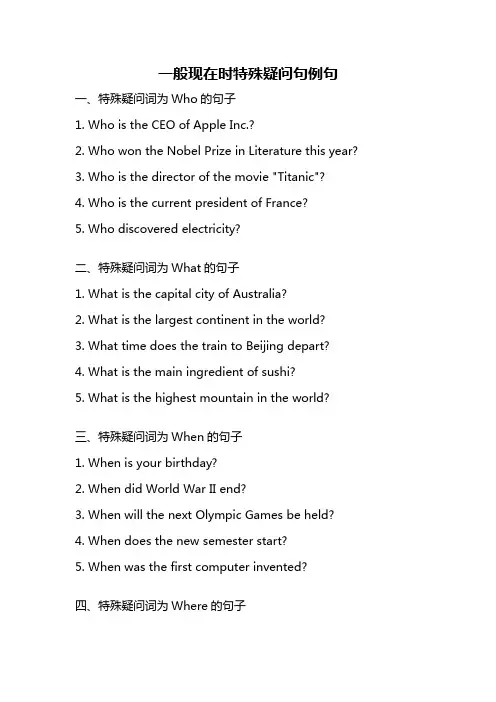
一般现在时特殊疑问句例句一、特殊疑问词为Who的句子1. Who is the CEO of Apple Inc.?2. Who won the Nobel Prize in Literature this year?3. Who is the director of the movie "Titanic"?4. Who is the current president of France?5. Who discovered electricity?二、特殊疑问词为What的句子1. What is the capital city of Australia?2. What is the largest continent in the world?3. What time does the train to Beijing depart?4. What is the main ingredient of sushi?5. What is the highest mountain in the world?三、特殊疑问词为When的句子1. When is your birthday?2. When did World War II end?3. When will the next Olympic Games be held?4. When does the new semester start?5. When was the first computer invented?四、特殊疑问词为Where的句子1. Where is the nearest post office?2. Where can I find a good restaurant around here?3. Where did you go on your last vacation?4. Where is the Eiffel Tower located?5. Where can I buy tickets for the concert?五、特殊疑问词为Why的句子1. Why did you choose to study abroad?2. Why is the sky blue?3. Why do birds fly south for the winter?4. Why did the company decide to close down?5. Why is it important to exercise regularly?六、特殊疑问词为How的句子1. How do you make a chocolate cake?2. How long does it take to get to the airport from here?3. How did you learn to speak English so fluently?4. How can I improve my writing skills?5. How does a microwave oven work?七、特殊疑问词为Which的句子1. Which is your favorite color?2. Which book are you currently reading?3. Which country won the World Cup last year?4. Which team won the Super Bowl this year?5. Which movie won the Best Picture at the Oscars?八、特殊疑问词为Whose的句子1. Whose car is parked in front of the house?2. Whose idea was it to go hiking this weekend?3. Whose phone is ringing?4. Whose dog is barking outside?5. Whose turn is it to do the dishes?九、特殊疑问词为How many的句子1. How many students are in your class?2. How many books have you read this year?3. How many languages can you speak?4. How many hours of sleep do you get each night?5. How many people attended the concert last night?十、特殊疑问词为How much的句子1. How much does a ticket to the concert cost?2. How much money do you have in your wallet?3. How much does a cup of coffee cost at this cafe?4. How much time do you spend studying every day?5. How much does it cost to rent an apartment in this city?。

一般现在时的被动语态知识点一、一般现在时被动语态的构成。
1. 肯定句。
- 结构为“am/is/are+过去分词”。
- 例如:- The book is written by him.(这本书是他写的。
)其中,the book是主语,is written是一般现在时的被动语态结构,write的过去分词是written,by him表示动作的执行者。
- I am often asked to help others.(我经常被要求去帮助别人。
)这里,I 是主语,am asked是被动语态结构,ask的过去分词是asked。
- They are given a lot of homework every day.(他们每天被布置很多家庭作业。
)they是主语,are given是被动语态结构,give的过去分词是given。
2. 否定句。
- 结构为“am/is/are + not+过去分词”。
- 例如:- The window isn't broken by the boy.(窗户不是那个男孩打破的。
)- I am not told the news.(我没有被告知这个消息。
)- They are not allowed to go out at night.(他们不被允许在晚上出去。
)3. 一般疑问句。
- 结构为“Am/Is/Are+主语+过去分词+(by...)?”- 例如:- Is the letter sent by her?(这封信是她寄的吗?)- Are you often invited to the party?(你经常被邀请参加聚会吗?)- Am I given a chance?(我被给予一个机会吗?)4. 特殊疑问句。
- 结构为“特殊疑问词+am/is/are+主语+过去分词+(by...)?”- 例如:- What is made in this factory?(这个工厂生产什么?)- Who are you taught by?(谁教你们?)- How is the work done?(这项工作是如何完成的?)二、一般现在时被动语态的用法。
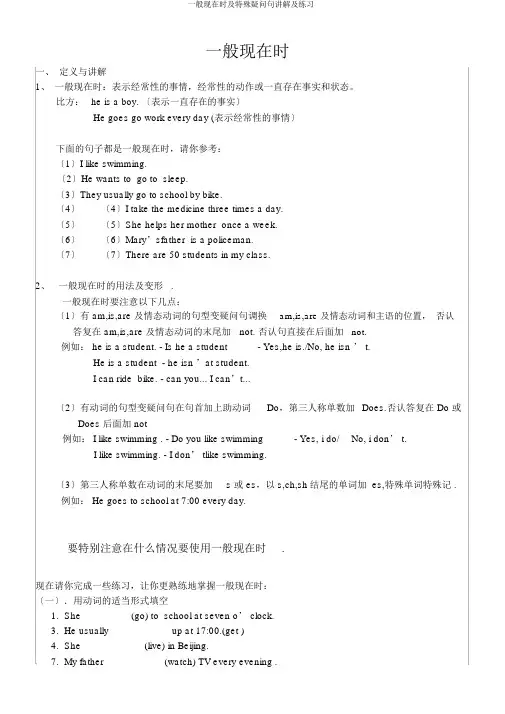
一般现在时一、定义与讲解1、一般现在时:表示经常性的事情,经常性的动作或一直存在事实和状态。
比方:he is a boy. 〔表示一直存在的事实〕He goes go work every day (表示经常性的事情〕下面的句子都是一般现在时,请你参考:〔1〕I like swimming.〔2〕He wants to go to sleep.〔3〕They usually go to school by bike.〔4〕〔4〕I take the medicine three times a day.〔5〕〔5〕She helps her mother once a week.〔6〕〔6〕Mary’sfather is a policeman.〔7〕〔7〕There are 50 students in my class.2、一般现在时的用法及变形.一般现在时要注意以下几点:〔1〕有 am,is,are 及情态动词的句型变疑问句调换am,is,are 及情态动词和主语的位置,否认答复在 am,is,are 及情态动词的末尾加not. 否认句直接在后面加not.例如: he is a student. - Is he a student - Yes,he is./No, he isn ’ t.He is a student - he isn ’at student.I can ride bike. - can you... I can’t...〔2〕有动词的句型变疑问句在句首加上助动词Do,第三人称单数加Does.否认答复在 Do 或Does 后面加 not例如: I like swimming . - Do you like swimming - Yes, i do/ No, i don’ t.I like swimming. - I don’ tlike swimming.〔3〕第三人称单数在动词的末尾要加s 或 es,以 s,ch,sh结尾的单词加 es,特殊单词特殊记 .例如: He goes to school at 7:00 every day.要特别注意在什么情况要使用一般现在时.现在请你完成一些练习,让你更熟练地掌握一般现在时:〔一〕.用动词的适当形式填空1.She _________(go) to school at seven o’ clock.3.He usually ___________ up at 17:00.(get )4.She ___________ (live) in Beijing.7.My father __________ (watch) TV every evening .9.________ Amy _________ (read) English every day10. Chen Jie sometimes _________(go)to the park with her sister.〔二〕 .选择填空1. I want____homework now.A. doingB. to doC. to do myD. do my2.It's time______.A. go to schoolB. play gamesC. to go homeD. to do my homeworks3.______go and help her.A. Let's meB. Let's usC. Let'sD. Let's to4.Do they have a new car Yes,_____.A .they are have C. they don't D. they do5.He often _________ supper at 6:00 in the evening.A. haveB. has c. is having D. is eating6. We _____________ any Chinese classes on Friday.A. are havingB. aren ’thavingC. don’t haveD. are have〔三〕、用括号内动词的适当形式填空。
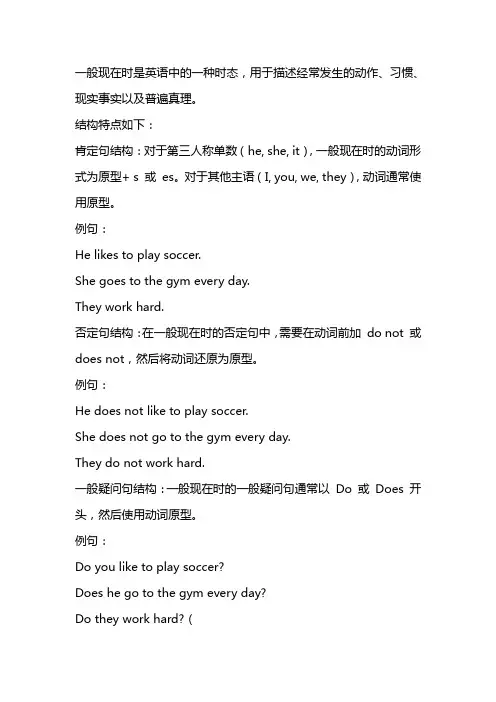
一般现在时是英语中的一种时态,用于描述经常发生的动作、习惯、现实事实以及普遍真理。
结构特点如下:
肯定句结构:对于第三人称单数(he, she, it),一般现在时的动词形式为原型+ s 或es。
对于其他主语(I, you, we, they),动词通常使用原型。
例句:
He likes to play soccer.
She goes to the gym every day.
They work hard.
否定句结构:在一般现在时的否定句中,需要在动词前加do not 或does not,然后将动词还原为原型。
例句:
He does not like to play soccer.
She does not go to the gym every day.
They do not work hard.
一般疑问句结构:一般现在时的一般疑问句通常以Do 或Does 开头,然后使用动词原型。
例句:
Do you like to play soccer?
Does he go to the gym every day?
Do they work hard?(
特殊疑问句结构:特殊疑问句通常以特殊疑问词(如what, when, where, why, how 等)开头,然后使用一般疑问句结构。
例句:
What do you like to do on weekends?
When does she go to the gym?
Why do they work hard?。
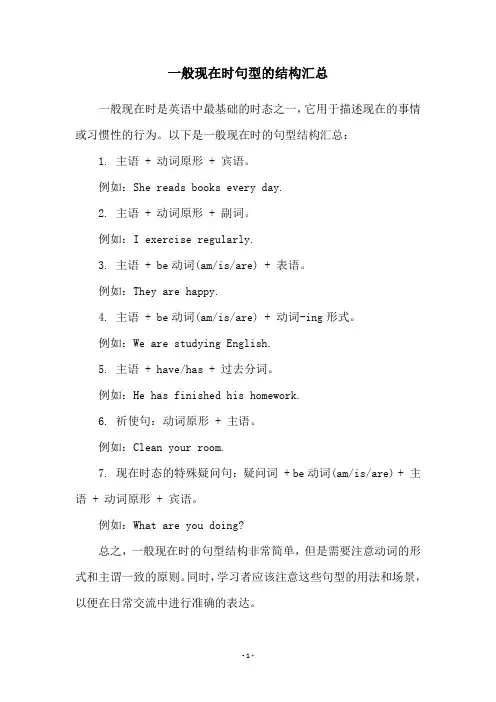
一般现在时句型的结构汇总
一般现在时是英语中最基础的时态之一,它用于描述现在的事情或习惯性的行为。
以下是一般现在时的句型结构汇总:
1. 主语 + 动词原形 + 宾语。
例如:She reads books every day.
2. 主语 + 动词原形 + 副词。
例如:I exercise regularly.
3. 主语 + be动词(am/is/are) + 表语。
例如:They are happy.
4. 主语 + be动词(am/is/are) + 动词-ing形式。
例如:We are studying English.
5. 主语 + have/has + 过去分词。
例如:He has finished his homework.
6. 祈使句:动词原形 + 主语。
例如:Clean your room.
7. 现在时态的特殊疑问句:疑问词 + be动词(am/is/are) + 主语 + 动词原形 + 宾语。
例如:What are you doing?
总之,一般现在时的句型结构非常简单,但是需要注意动词的形式和主谓一致的原则。
同时,学习者应该注意这些句型的用法和场景,以便在日常交流中进行准确的表达。
- 1 -。
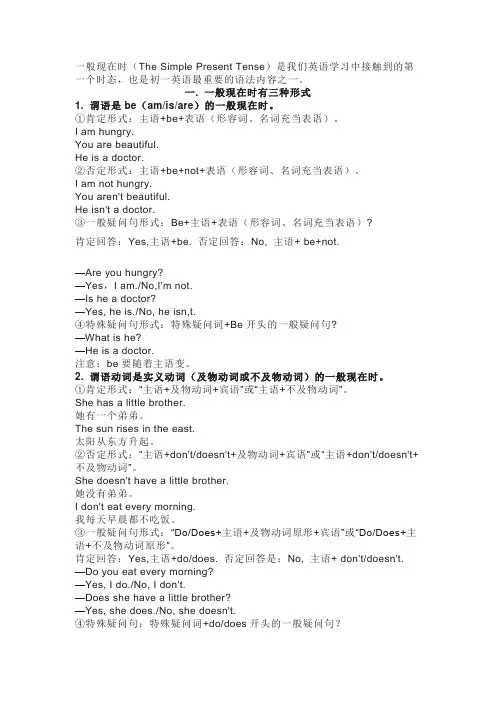
一般现在时(The Simple Present Tense)是我们英语学习中接触到的第一个时态,也是初一英语最重要的语法内容之一。
一. 一般现在时有三种形式1. 谓语是be(am/is/are)的一般现在时。
①肯定形式:主语+be+表语(形容词、名词充当表语)。
I am hungry.You are beautiful.He is a doctor.②否定形式:主语+be+not+表语(形容词、名词充当表语)。
I am not hungry.You aren't beautiful.He isn't a doctor.③一般疑问句形式:Be+主语+表语(形容词、名词充当表语)?肯定回答:Yes,主语+be. 否定回答:No, 主语+ be+not.—Are you hungry?—Yes,I am./No,I'm not.—Is he a doctor?—Yes, he is./No, he isn,t.④特殊疑问句形式:特殊疑问词+Be开头的一般疑问句?—What is he?—He is a doctor.注意:be要随着主语变。
2. 谓语动词是实义动词(及物动词或不及物动词)的一般现在时。
①肯定形式:“主语+及物动词+宾语”或“主语+不及物动词”。
She has a little brother.她有一个弟弟。
The sun rises in the east.太阳从东方升起。
②否定形式:“主语+don't/doesn't+及物动词+宾语”或“主语+don't/doesn't+不及物动词”。
She doesn't have a little brother.她没有弟弟。
I don't eat every morning.我每天早晨都不吃饭。
③一般疑问句形式:“Do/Does+主语+及物动词原形+宾语”或“Do/Does+主语+不及物动词原形”。

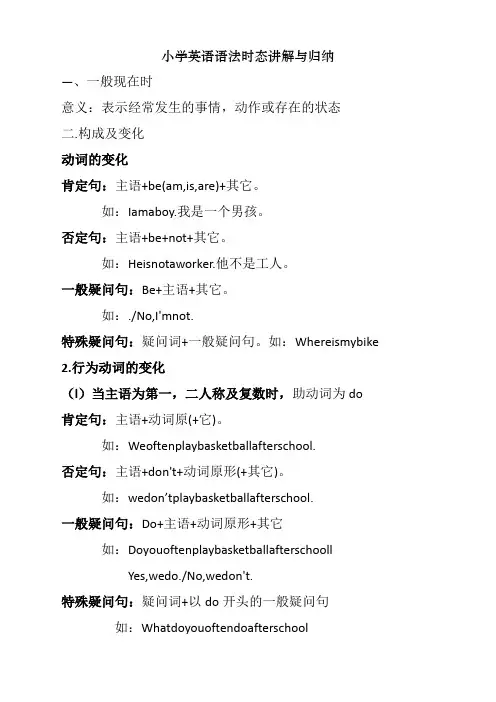
小学英语语法时态讲解与归纳—、一般现在时意义:表示经常发生的事情,动作或存在的状态二.构成及变化动词的变化肯定句:主语+be(am,is,are)+其它。
如:Iamaboy.我是一个男孩。
否定句:主语+be+not+其它。
如:Heisnotaworker.他不是工人。
一般疑问句:Be+主语+其它。
如:./No,I'mnot.特殊疑问句:疑问词+一般疑问句。
如:Whereismybike 2.行为动词的变化(l)当主语为第一,二人称及复数时,助动词为do肯定句:主语+动词原(+它)。
如:Weoftenplaybasketballafterschool.否定句:主语+don't+动词原形(+其它)。
如:wedon’tplaybasketballafterschool.一般疑问句:Do+主语+动词原形+其它如:DoyouoftenplaybasketballafterschoollYes,wedo./No,wedon't.特殊疑问句:疑问词+以do开头的一般疑问句如:Whatdoyouoftendoafterschool(2)当主语为第三人称单数时,助动词为does肯定句:主语+动词三单式(+其它)。
如:Heswimswell.否定句:主语+doesn’t+动词原形(+其它)。
如:Hedoesn’tswim well.一般疑问句:Does+主语+动词原形+其它。
如:DoesheswimwellYes,hedoes./No,hedoesn't.特殊疑问句:疑问词+以does开头的一般疑问句如:Howdoesyourfathergotowork三.第三人称单数的动词变化规则(只有在第三人称为主语的肯定句中,动词才用三单式)(1)多数动词直接加s:runs getslikescolletstakesplays climbs…….(2)结尾是s,x,sh,ch,o,前为辅音字母,结尾加es:watches teaches goes does washes crossesmixes brushes(3)动词末尾y前为辅音:将y改为i加es:study→studiesfly→fliescarry→carriescry→cries但在y前如果为元音则直接加s:buyssays四.时间标志:always,usually,often,so metimes,every…一般现在时练习Heoften (have)dinnerathome. DanielandTommy (be)inClassOne.We (notwatch)TVonMonday.Nick (notgo)tothezooonSunday.they (like)theWorldCupWhattheyoften (do)onSaturdaysyourparents(read)newspaperseverydayThegirl (teach)usEnglishonSundays.SheandI(take)awalktogethereveryevening.There(be)somewaterinthebottle.Mike____(like)cooking.They____ (have)thesamehobby.Myaunt____(look)afterherbabycarefully. Youalways______(do)yourhomeworkwell.I (be)’mstayinginbed.She (go)toschoolfromMondaytoFriday.LiuTao_____(do)notlikePE.Thechildoften_____(watch)TVintheevening. SuHaiandSuYang____(have)eightlessonsthisterm.-Whatday___(be)ittoday-It’sSaturdayWinter, spring, summer and autumn (be)seasons.Danny (take) off his T-shirt now.Today (teach) a science lesson.Jenny and I (live) in Canada.Jenny (want) to go to school in chinaLet me (help) youShe eats a sandwich(总是)Li Ming goes to school by bicycle(有时)。
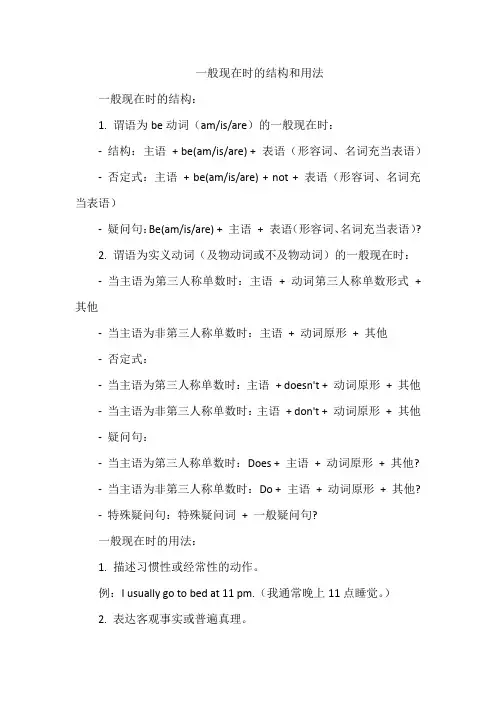
一般现在时的结构和用法一般现在时的结构:1. 谓语为be动词(am/is/are)的一般现在时:-结构:主语+ be(am/is/are) + 表语(形容词、名词充当表语)-否定式:主语+ be(am/is/are) + not + 表语(形容词、名词充当表语)-疑问句:Be(am/is/are) + 主语+ 表语(形容词、名词充当表语)?2. 谓语为实义动词(及物动词或不及物动词)的一般现在时:-当主语为第三人称单数时:主语+ 动词第三人称单数形式+ 其他-当主语为非第三人称单数时:主语+ 动词原形+ 其他-否定式:-当主语为第三人称单数时:主语+ doesn't + 动词原形+ 其他-当主语为非第三人称单数时:主语+ don't + 动词原形+ 其他-疑问句:-当主语为第三人称单数时:Does + 主语+ 动词原形+ 其他?-当主语为非第三人称单数时:Do + 主语+ 动词原形+ 其他?-特殊疑问句:特殊疑问词+ 一般疑问句?一般现在时的用法:1. 描述习惯性或经常性的动作。
例:I usually go to bed at 11 pm.(我通常晚上11点睡觉。
)2. 表达客观事实或普遍真理。
例:The sun rises in the east.(太阳从东方升起。
)3. 描述时间表或日程安排。
例:The train leaves at 8 am.(火车早上8点发车。
)4. 在新闻报道或科技文章中描述当前状况。
例:The company is developing a new product.(该公司正在开发一款新产品。
)。
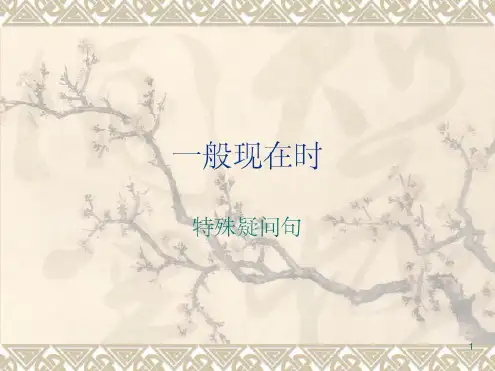
小学英语语法时态讲解与归纳—、一般现在时意义:表示经常发生的事情,动作或存在的状态二。
构成及变化1.be动词的变化肯定句:主语+be(am,is,are)+其它。
如:I am a boy。
我是一个男孩。
否定句:主语+be+not+其它。
如:He is not a worker.他不是工人.一般疑问句:Be+主语+其它。
如:-Are you a student?-Yes。
I am。
/No,I’m not.特殊疑问句:疑问词+一般疑问句。
如:Where is my bike?2.行为动词的变化(l)当主语为第一,二人称及复数时,助动词为do肯定句:主语+动词原(+它)。
如:We often play basketball after school。
否定句:主语+don’t+动词原形(+其它).如:we don’t play basketball after school。
一般疑问句:Do+主语+动词原形+其它?如:Do you often play basketball after school l?Yes,we do./No,we don’t.特殊疑问句:疑问词+以do开头的一般疑问句?如:What do you often do after school?(2)当主语为第三人称单数时,助动词为does肯定句:主语+动词三单式(+其它).如:He swims well。
否定句:主语+doesn’t+动词原形(+其它)。
如:He doesn't swim well.一般疑问句:Does+主语+动词原形+其它。
如:Does he swim well?Yes,he does。
/No,he doesn't.特殊疑问句:疑问词+以does开头的一般疑问句?如:How does your father go to work?三.第三人称单数的动词变化规则(只有在第三人称为主语的肯定句中,动词才用三单式)(1)多数动词直接加s:runs gets likes collets takes plays climbs…….(2)结尾是s,x,sh,ch,o,前为辅音字母,结尾加es:watches teaches goes does washes crossesmixes brushes(3)动词末尾y前为辅音:将y改为i加es:study→studies fly→flies carry→carries cry→cries但在y前如果为元音则直接加s:buys says四.时间标志:always,usually,often,sometimes,every…一般现在时练习He often (have) dinner at home.Daniel and Tommy (be) in Class One。